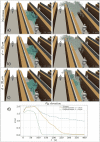Airborne transmission of biological agents within the indoor built environment: a multidisciplinary review
- PMID: 36467894
- PMCID: PMC9703444
- DOI: 10.1007/s11869-022-01286-w
Airborne transmission of biological agents within the indoor built environment: a multidisciplinary review
Abstract
The nature and airborne dispersion of the underestimated biological agents, monitoring, analysis and transmission among the human occupants into building environment is a major challenge of today. Those agents play a crucial role in ensuring comfortable, healthy and risk-free conditions into indoor working and leaving spaces. It is known that ventilation systems influence strongly the transmission of indoor air pollutants, with scarce information although to have been reported for biological agents until 2019. The biological agents' source release and the trajectory of airborne transmission are both important in terms of optimising the design of the heating, ventilation and air conditioning systems of the future. In addition, modelling via computational fluid dynamics (CFD) will become a more valuable tool in foreseeing risks and tackle hazards when pollutants and biological agents released into closed spaces. Promising results on the prediction of their dispersion routes and concentration levels, as well as the selection of the appropriate ventilation strategy, provide crucial information on risk minimisation of the airborne transmission among humans. Under this context, the present multidisciplinary review considers four interrelated aspects of the dispersion of biological agents in closed spaces, (a) the nature and airborne transmission route of the examined agents, (b) the biological origin and health effects of the major microbial pathogens on the human respiratory system, (c) the role of heating, ventilation and air-conditioning systems in the airborne transmission and (d) the associated computer modelling approaches. This adopted methodology allows the discussion of the existing findings, on-going research, identification of the main research gaps and future directions from a multidisciplinary point of view which will be helpful for substantial innovations in the field.
Keywords: Airborne transmission; Bioaerosols; Building ventilation; CFD models; Droplets; Indoor air quality.
© The Author(s), under exclusive licence to Springer Nature B.V. 2022, Springer Nature or its licensor (e.g. a society or other partner) holds exclusive rights to this article under a publishing agreement with the author(s) or other rightsholder(s); author self-archiving of the accepted manuscript version of this article is solely governed by the terms of such publishing agreement and applicable law.
Conflict of interest statement
Conflict of interestThe authors declare no competing interests.
Figures















Similar articles
-
Air cleaning technologies: an evidence-based analysis.Ont Health Technol Assess Ser. 2005;5(17):1-52. Epub 2005 Nov 1. Ont Health Technol Assess Ser. 2005. PMID: 23074468 Free PMC article.
-
A review of strategies and their effectiveness in reducing indoor airborne transmission and improving indoor air quality.Environ Res. 2022 Oct;213:113579. doi: 10.1016/j.envres.2022.113579. Epub 2022 Jun 14. Environ Res. 2022. PMID: 35714688 Free PMC article.
-
The Impact of Heating, Ventilation, and Air-Conditioning Design Features on the Transmission of Viruses, Including SARS-CoV-2: Overview of Reviews.Interact J Med Res. 2022 Dec 23;11(2):e37232. doi: 10.2196/37232. Interact J Med Res. 2022. PMID: 36343208 Free PMC article. Review.
-
Role of mechanical ventilation in the airborne transmission of infectious agents in buildings.Indoor Air. 2016 Oct;26(5):666-78. doi: 10.1111/ina.12267. Epub 2015 Dec 14. Indoor Air. 2016. PMID: 26562748 Free PMC article. Review.
-
Automated infection risks assessments (AIRa) for decision-making using a blockchain-based alert system: A case study in a representative building.Environ Res. 2023 Jan 1;216(Pt 3):114663. doi: 10.1016/j.envres.2022.114663. Epub 2022 Oct 29. Environ Res. 2023. PMID: 36341792
Cited by
-
Editorial for Special Issue: "Airborne Microbes and Their Potential Influence".Microorganisms. 2024 Feb 9;12(2):361. doi: 10.3390/microorganisms12020361. Microorganisms. 2024. PMID: 38399765 Free PMC article.
-
Aspergillus fumigatus in the Food Production Chain and Azole Resistance: A Growing Concern for Consumers.J Fungi (Basel). 2025 Mar 26;11(4):252. doi: 10.3390/jof11040252. J Fungi (Basel). 2025. PMID: 40278073 Free PMC article. Review.
-
Role of Antimicrobial Air Purifier in Reducing the Microbial Load in the Critical Care Unit in Oncology Center: An Intervention Study.Indian J Crit Care Med. 2025 Apr;29(4):327-332. doi: 10.5005/jp-journals-10071-24910. Indian J Crit Care Med. 2025. PMID: 40322224 Free PMC article.
References
-
- Ahmed N, Glencross H, Wang Q (2016) Biomedical Science practice: experimental & professional skills. Oxford University Press, Oxford
-
- Ai ZT, Huang T, Melikov AK. Airborne transmission of exhaled droplet nuclei between occupants in a room with horizontal air distribution. Build Environ. 2019;163:106328. doi: 10.1016/j.buildenv.2019.106328. - DOI
-
- Ai ZT, Mak CM. A study of interunit dispersion around multistory buildings with single-sided ventilation under different wind directions. Atmos Environ. 2014;88:1–13. doi: 10.1016/j.atmosenv.2014.01.049. - DOI
Publication types
LinkOut - more resources
Full Text Sources
Miscellaneous
